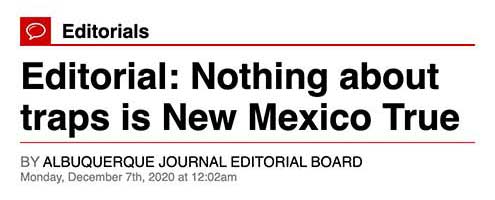 BY ALBUQUERQUE JOURNAL EDITORIAL BOARD
BY ALBUQUERQUE JOURNAL EDITORIAL BOARD
Monday, December 7th, 2020 at 12:02am
New Mexicans have worked hard over the years to do right by the animals in our state. We have banned cockfighting, horse tripping and coyote-killing contests. We have made dog fighting a fourth-degree felony. We have created a dedicated funding stream for low-cost spay and neuter services.
And now it is time we finally stop allowing the brutal, indiscriminate use of traps on our public lands.
For a paltry $20 permit, members of a small and vocal minority are allowed to litter our amazing public lands with as many leg-hold, body-gripping and cage traps, snares and poisons as they want. There is no limit to the number of animals they can maim and kill. No requirement they take only a certain species or gender or quickly put a suffering animal out of its misery. They can leave their traps unchecked for up to two days as anything suffers in them.
And since Nov. 1, three pet dogs have been caught in these traps (including Jesse, a 2-year-old Dutch shepherd who suffered minimal injuries from a trap in the Jemez National Recreation Area on Thanksgiving, and Mahlia, a black lab who lost many of her toes in a trap in northern Santa Fe County). Meanwhile, a hiker in Doña Ana County found a gruesome pile of more than a dozen skinned coyote carcasses, many with obvious trapping wounds on their legs. A map from TrapFree New Mexico shows incidents of traps catching people, pets and the wrong kind of animal stretch across our national forest, BLM and state trust lands.
Put that on a tourism ad.
The window dressing of “updates” the feckless state Game and Fish Department adopted last year to make trapping more palatable was just that, and real reforms are past due.
Jessica Johnson of Animal Protection Voters New Mexico says that once again, her group and others will advocate for Roxy’s Law, aka the Wildlife Protection and Public Safety Act. (It is named for family dog Roxy, an 8-year-old blue heeler-mix that strangled to death in a neck snare at Santa Cruz Lake in 2018. Her owner desperately, unsuccessfully, tried to save her.)
Versions of this reasonable legislation died in the 2017 and 2019 legislative sessions, so it is important to emphasize again to lawmakers and the public alike that it:
- Pertains only to public land, not private property.
- Does not affect hunting with firearms, archery, fishing or falconry equipment.
- Still allows trapping of mice, rats, pack rats, gophers, prairie dogs, moles, voles, rock squirrels, birds or fish.
- Provides exceptions for bona fide scientific research as well as government agencies to prevent/mitigate threats to human health and safety and address livestock depredation.
- Allows cage traps to capture wildlife and feral and domesticated animals that cause damage to property, crops or livestock, as well as to recover a domesticated animal or trap-neuter-release a feral animal.
- Exempts members of federally recognized Indian nations, tribes and pueblos for religious or ceremonial purposes.
New Mexico has long been an outlier on trapping. Colorado and California have banned it statewide, and Arizona and Washington have banned it on public land. That’s because they recognize trapping is indiscriminate, cruel, threatens recreationists and tourists, kills our threatened and endangered species (at least eight Mexican gray wolves in New Mexico) and, because there are no bag limits, presents a real threat to our already threatened ecosystem.
Trapping is in no way “New Mexico True.” New Mexico needs to make 2021 the year it adds a ban on trapping on public lands to its important list of successful animal and wildlife legislation.
This editorial first appeared in the Albuquerque Journal. It was written by members of the editorial board and is unsigned as it represents the opinion of the newspaper rather than the writers.
